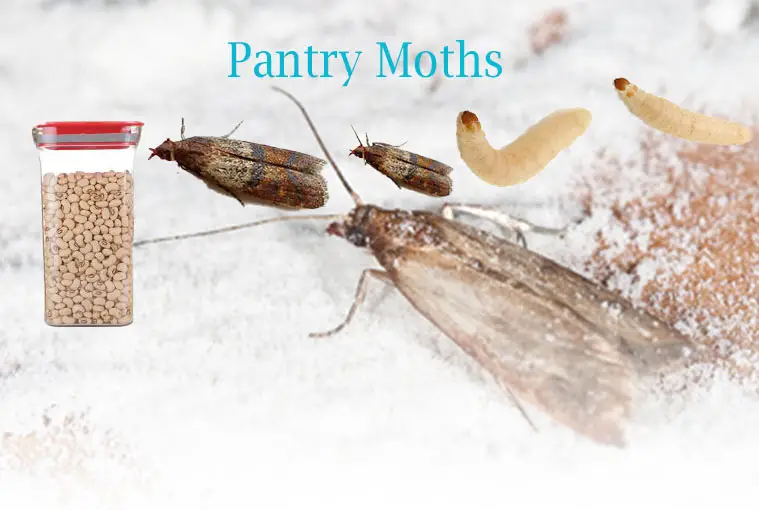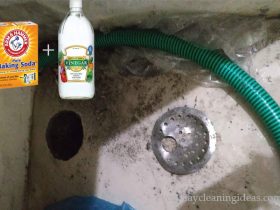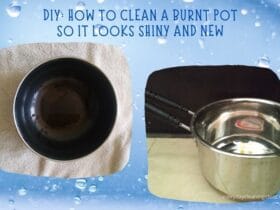Pantry moths, or the Indian meal moths, infest pantries and food cabinets in the kitchen.
One of my friends was away on holiday for a couple of weeks. When she was back after a couple of weeks, a dozen had flown out of her pantry when she opened it. Some she managed to swat, some she managed to kill with a bug spray, while the rest flew out the window.
The point is, if you too see pantry moths flying out of your kitchen cabinet, then chances are, your cabinets and kitchen already have a moth infestation.
While pantry moths are not harmful in themselves, because they do not have a harmful bite, they can still contaminate your food which could lead to diseases like diarrhea and other stomach problems.
Where do pantry moths grow the most?
- Open cereal boxes inside cabinets
- Trash cans under the counter
- Leftover bread, grains, and dry food items
To get rid of kitchen moths for good, you have to apply a three-step procedure for cleaning.
- Clean out the pantry moth eggs and larvae
- Kill the adult pantry moths
- Prevent moths from returning.
1. Cleaning out pantry moth eggs and larvae
You must not blame yourself that your kitchen is infested with moths because of your inadequate cleaning. Moths will lay eggs and grow where there is ample food and in dark and quiet places. No one knows where the moths come from, but you suddenly find them in your food.
Pantries and kitchen cabinets are not cleaned to the corners daily. There are corners and shelves in the pantry that lay untouched for weeks, simply because you might not need the food items or ingredients for some time.
Moreover, pantry moths can chew through paper and plastic, which is why even if you have kept your boxes shut, they might still have found a way into your food. A single moth can lay up to 400 eggs at a time. So, it is important to clean them away quickly to prevent a massive outbreak.
Here is what you should do to clean out the eggs and larvae.
- First, throw away all open boxes of grains and cereals. It could flour, rice, or your morning cereals.
- Remember, even if you cannot see the eggs or larvae, they are there. If there were adult moths inside the cabinet, they would have laid pantry moth eggs.
- Do not throw the open food packets inside the trash can under the counter. The moths in the house will get there too.
- Carry the trash can as well as the open boxes, right outside your house. Do not wait for the trash till the next morning.
- Clean out the cupboard of all the sealed items of food. But do not just keep them aside. Wipe them with a solution of soapy water and vinegar by dipping a piece of cloth. Glass jars and sealed boxes will be easier to clean this way.
- Remove any peeling or torn liners on the shelves. The open edges provide the perfect nook to the moths to lay their eggs and this is where the larvae are also lodged.
- Then, thoroughly scrub inside the cabinet with a mixture of natural disinfectant and soapy water.
To make this,
- Take some dishwashing solution in a bowl.
- Mix one full lemon inside it, with two teaspoons of white vinegar, and boric acid.
- Give it a stir and scrub the shelves with a washcloth dipped in the solution.
The boric acid and vinegar will remove all traces of the eggs and kill the larvae. The soap will remove any food stains or dirt on the shelves or corners which can attract not only moths but all other kinds of insects. The lime will leave behind a fresh scent.
2. Getting rid of pantry moths
If the larvae have already turned into tiny moths in the house, then you will have to kill them. While it might seem tempting to use a commercial bug spray, it is prudent not to use such heavy chemicals inside the kitchen.
Moreover, it has been noticed that pantry moths are also highly resilient to such sprays.
Here is what you can do to repel moths.
- Use a Pheromone Trap: These traps are efficient in trapping moths. You can place them around the kitchen. The traps have a sticky surface that attracts the moths and then they cannot get away. They are either exhausted or die in the effort or you could take them outside and then use a bug spray on them.
- Bug zapper: Bug zappers are efficient but you have to be around to use them. Wave them at the flying moths and they will die due to electrocution. You will also probably end up killing some flies in the process.
- Leaving Boric Acid on the counter: Boric acid is very poisonous for animals and pests. You can sprinkle some boric acid on the kitchen countertops and the shelves of the pantry, mixing it with sugar powder. The moths, as well as pantry flies, will be attracted to the smell of sugar but will die on the consumption of the boric acid.
Once you see moths dropping dead, make sure you clean them away thoroughly. Dead insects can attract ants and other kinds of pests who feed on them.
Adult pantry moths are the greatest source of contamination because they can fly around the house, contaminating one food item and another. They will lay eggs in every possible corner, and not only limited to your kitchen. We often have food items in our dining rooms as well. So, before you know it, they could have also traveled to the other areas of the house.
Another way to tackle them is to use covered trash cans. Open trash cans can attract not just moths but also all kinds of pests. Make sure you clean them out every day, especially if you throw food scraps into it. Before you leave your home for an extended period of time, make sure they are emptied out and closed tightly shut.
3. Prevent moths from returning
This is the biggest challenge you have to take up while getting rid of pantry moths. Once the insects have found a haven to lay their eggs, they have a propensity to return to those places.
Here are some things you can do to prevent moths.
- Remove anything from your kitchen cabinet or pantry that can attract the moths.
- Since the moths are mostly attracted to food, make sure you do not leave open food around.
- Transfer all dry food items like cereals, nuts, coffee, grains, sugar, dry fruits, or pet food in airtight, sealed containers. If you do not have so many airtight containers, at least use glass jars.
- Transfer food items like chocolates, candies, seeds, and spices into the refrigerator.
- Before you transfer, check the seemingly intact packets for any holes. Pantry moth worms could have chewed right through them and you could just be transferring contaminated food into sealed containers.
- Do not leave any food in the pantry for more than a week, at most ten days. Try to utilize the food or give it away to someone needy, rather than hoarding them. Stale food is one of the biggest attractions for moths and other pests.
- Shop smartly. Do not buy food in bulk unless you can store them away properly in airtight containers.
- Transfer all food items to tight jars and cans as soon as you bring them home and discard the paper packets and boxes.
- Store away pet food and bird food outside the kitchen, in the basement, in tight jars.
- Most importantly, make sure your kitchen gets a lot of natural ventilation. Any kind of pests will grow uncontrollably in such conditions, so make sure you have enough natural sunlight.
- Since you cannot use chemical disinfectants in your kitchen cabinets, opt for natural options to keep moths away.
- Crush some dried bay leaves and sprinkle it on the counters and shelves. It will keep pests away and also absorb any bad odor.
- You can also place pots of mint and basil on the kitchen windowsill or in the corners. These plants repel moths and other kinds of pests.
- You can also burn rosemary, sage, and lavender in a small container and use the smoke to fumigate your kitchen and pantry from time to time.
- Make sure there are no open edges or upturned kitchen shelf liners. Moths tend to lay eggs under them.
- Check for moth larvae on the ceiling, especially if there are damp patches in your kitchen. If you find larvae there, then it is a good idea to clean out your kitchen thoroughly as well.
Other kinds of moths in the house
Other than pantry moths, you can also find other species of moths nearby. For example, the moths inside your grain tub could be rice moth. Moreover, moths can travel far from the place of their birth, so they could have gone to the other parts of your house as well.
Carpet moths tend to cling to musty and damp carpets, so take care to clean them thoroughly from time to time. Or else, at least leave them out in the sunlight every couple of weeks or so.
Some kinds of moths eat clothes so try to clean out your wardrobes as well from time to time. Take out all items of clothing and discard anything you have not worn in the last year. Wash the others, or place them in strong sunlight to kill clothes bugs and moth eggs. Place them naphthalene balls inside the cupboards as you put them back. This is one of the easiest ways to kill moths.
With these methods, you can get rid of moths in kitchen cabinets for good and pave the way for a clean and safe pantry in the kitchen, greatly reducing the chances of food contamination.









Leave a Reply
View Comments